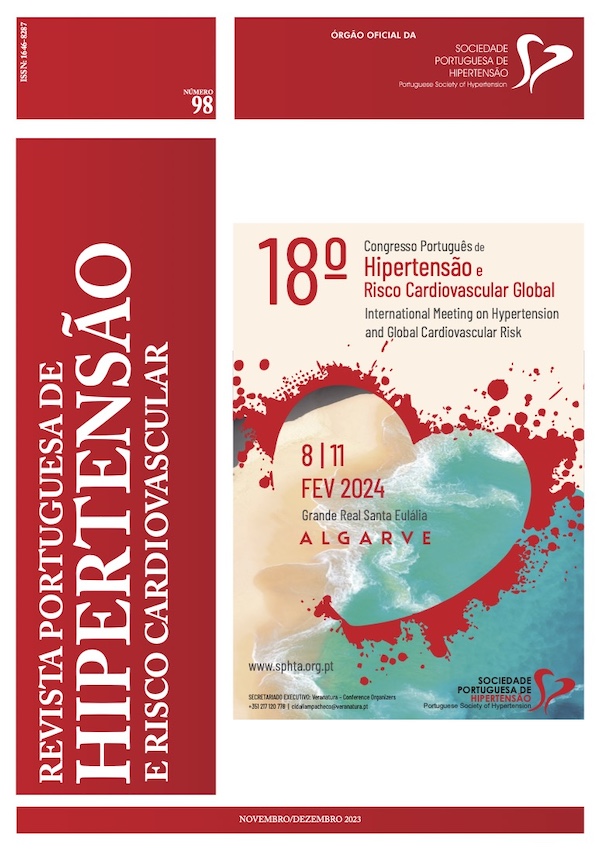THE IMPORTANCE OF MEDICAL SEMIOLOGY – A CASE OF SUBCLAVIAN STEAL SYNDROME
DOI:
https://doi.org/10.58043/rphrc.71Keywords:
Arterial hypertension, Subclavian Steal SyndromeAbstract
Subclavian steal syndrome results from flow’s reversal in the vertebral artery as a result of hemodynamically significant stenosis/occlusion of the subclavian artery’s prevertebral segment. It is relatively rare (estimated european prevalence 1.3%), largely due to underdiagnosis. In addition to the sensory and motor manifestations of the affected limb, the main complications include vertebrobasilar insufficiency and transient cerebral ischemia.We present a case of an apparently asymptomatic 61-year-old woman, who came to the surveillance consultation. As this is the first contact between doctor/patient, blood pressure (BP) is measured in both upper extremities (UE), with a difference between the left (LUE) and right (RUE) upper extremities greater than 15 mmHg (BP LUE 147/94 mmHg and BP RUE 120/83 mmHg), maintained after serial measurements. Palpable pulses in the RUE were absent, despite of broad, rhythmic and regular radial and humeral pulses in the LUE. There were no other findings on examination, namely in the ankle-arm index and the pulses of the lower limbs. She reported having suspended the antihypertensive therapy about a year and a half ago due to poor tolerability, but revealing apparent BP control without any medication during the measurements that she habitually took at home exclusively in the RUE. Monotherapy antihypertensive therapy was reintroduced at the minimum necessary dose and an ultrasound with UE and carotid arterial Doppler study was requested. Subsequently, BP normalization was verified in the LUE with good tolerability to the antihypertensive, but the differential between UE remained. When questioned again about previous symptoms, the patient recalls sporadic morning paresthesias, but recurrent and localized to the RUE, which she associated with compression during sleep.
The tests performed detected an “inversion of flow in the right vertebral artery and a marked reduction in flow in the right subclavian artery were detected, suggestive of stenosis of the brachiocephalic arterial trunk with complete subclavian steal syndrome (...) and the presence of arterial insufficiency with velocity curves biphasic in all RUE arterial axes”. She was referred to a Vascular Surgery consultation, where platelet antiaggregation was started and CT angiography was requested, which confirmed the diagnosis. Due to the paresthesias’ worsening and onset of paresis in the same limb, she was proposed for catheterization, which was performed successfully. After the intervention, the patient no longer showed symptoms or BP differential between UE.
This case reinforces the importance of a complete anamnesis, supported by effective communication, and a targeted but meticulous examination, the pillars of medical semiology, for early detection of nosological entities with potential impact on the quality of life of patients, avoiding an exhausting and unnecessary investigation. Active and reflective listening to the patient about his condition, complaint or concern leads to real “clues” for the diagnostic hypotheses, a spectrum that narrows when the best practices related to the medical examination are respected.
Downloads
References
- Potter, B., Pinto, D. Subclavian Steal Syndrome. Circulation 2014; 129:2320–2323
- Granito, S., Azevedo, I. Atherosclerosis – apropos of a subclavian steal phenomenon. Sociedade Portuguesa de Medicina Interna 2011; volume 18, número 1.
- Saha T., Naqvi SY. Subclavian Artery Disease: Diagnosis and Therapy. The American Journal of Medicine 2017; 130(4):409.
- Gutierrez GR., Mahrer P. Prevalence of subclavian artery stenosis in patients with peripheral vascular disease. Angiology 2001; 52(3):189.
- Labropoulos N., Nandivada P. Prevalence and impact of the subclavian steal syndrome. Annals of Surgery 2010; 252(1):166.
- Shadman R., Criqui MH. Subclavian artery stenosis: prevalence, risk factors, and association with cardiovascular diseases. Journal of the American College of Cardiology 2004; 44(3):618-23.
- Cua B., Mamdani N. Review of coronary subclavian steal syndrome. Journal of Cardiology 2017; 70(5):432.
- Clark, C., Taylor, R. Association of a difference in systolic blood pressure between arms with vascular disease and mortality: a systematic review and meta-analysis. Lancet 2012; 379:905–914.
- Wang K., Wang Z. Long-term results of endovascular therapy for proximal subclavian arterial obstructive lesions. Chinese Medical Journal 2010; 3:45–50.
- Rockman, C. The Vertebral Artery in the Vascular Lab: What Does It Mean? New York University Langone edical Center
Downloads
Published
How to Cite
Issue
Section
License
Copyright (c) 2023 João R. Nunes Pires, Raquel Baptista Leite, Catarina Moita, Ana Sofia R. Silva, Violeta Florova

This work is licensed under a Creative Commons Attribution 4.0 International License.




